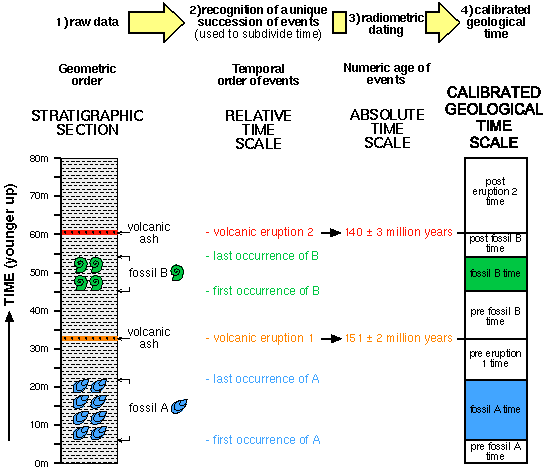- What is Radiometric Dating?
- How Do Scientists Determine the Age of Dinosaur Bones?
- How Is Radioactive Dating Used to Date Fossils? | Sciencing
- Absolute Dating
Radiation levels do not remain constant over time. Fluctuating levels can skew results — for example, if an item went through several high radiation eras, thermoluminescence will return an older date for the item. Many factors can spoil the sample before testing as well, exposing the sample to heat or direct light may cause some of the electrons to dissipate, causing the item to date younger. It cannot be used to accurately date a site on its own. However, it can be used to confirm the antiquity of an item.
Optically stimulated luminescence OSL dating constrains the time at which sediment was last exposed to light. During sediment transport, exposure to sunlight 'zeros' the luminescence signal. Upon burial, the sediment accumulates a luminescence signal as natural ambient radiation gradually ionises the mineral grains. Careful sampling under dark conditions allows the sediment to be exposed to artificial light in the laboratory which releases the OSL signal.
The amount of luminescence released is used to calculate the equivalent dose De that the sediment has acquired since deposition, which can be used in combination with the dose rate Dr to calculate the age. Dendrochronology or tree-ring dating is the scientific method of dating based on the analysis of patterns of tree rings , also known as growth rings.
What is Radiometric Dating?
Dendrochronology can date the time at which tree rings were formed, in many types of wood, to the exact calendar year. Dendrochronology has three main areas of application: In some areas of the world, it is possible to date wood back a few thousand years, or even many thousands. Currently, the maximum for fully anchored chronologies is a little over 11, years from present.
Amino acid dating is a dating technique [5] [6] [7] [8] [9] used to estimate the age of a specimen in paleobiology , archaeology , forensic science , taphonomy , sedimentary geology and other fields. This technique relates changes in amino acid molecules to the time elapsed since they were formed.
All biological tissues contain amino acids. All amino acids except glycine the simplest one are optically active , having an asymmetric carbon atom. This means that the amino acid can have two different configurations, "D" or "L" which are mirror images of each other. With a few important exceptions, living organisms keep all their amino acids in the "L" configuration.
- online dating website business model?
- Relative Dating.
- Pre/Post-Test Key!
- valentine 2 matchmaking;
- Radioactive Dating | BioNinja.
When an organism dies, control over the configuration of the amino acids ceases, and the ratio of D to L moves from a value near 0 towards an equilibrium value near 1, a process called racemization. Thus, measuring the ratio of D to L in a sample enables one to estimate how long ago the specimen died. From Wikipedia, the free encyclopedia. This section does not cite any sources. Please help improve this section by adding citations to reliable sources.
Unsourced material may be challenged and removed. July Learn how and when to remove this template message. Archaeology of ancient Mexico and Central America: Down to Earth Fifth edition. American Journal of Archaeology. Annual Review of Earth and Planetary Sciences. International Journal of Chemical Kinetics. The results provide a compelling case for applicability of amino acid racemization methods as a tool for evaluating changes in depositional dynamics, sedimentation rates, time-averaging, temporal resolution of the fossil record, and taphonomic overprints across sequence stratigraphic cycles.
How Do Scientists Determine the Age of Dinosaur Bones?
Chronometric dating in archaeology, edited by R. Taylor and Martin J. Plenum Press in cooperation with the Society for Archaeological Sciences. Canon of Kings Lists of kings Limmu. Chinese Japanese Korean Vietnamese. Lunisolar Solar Lunar Astronomical year numbering. Deep time Geological history of Earth Geological time units.
How Is Radioactive Dating Used to Date Fossils? | Sciencing
Chronostratigraphy Geochronology Isotope geochemistry Law of superposition Luminescence dating Samarium—neodymium dating. Amino acid racemisation Archaeomagnetic dating Dendrochronology Ice core Incremental dating Lichenometry Paleomagnetism Radiometric dating Radiocarbon Uranium—lead Potassium—argon Tephrochronology Luminescence dating Thermoluminescence dating.
Fluorine absorption Nitrogen dating Obsidian hydration Seriation Stratigraphy. Each of them typically exists in igneous rock, or rock made from cooled magma. Fossils, however, form in sedimentary rock -- sediment quickly covers a dinosaur's body, and the sediment and the bones gradually turn into rock. But this sediment doesn't typically include the necessary isotopes in measurable amounts. Fossils can't form in the igneous rock that usually does contain the isotopes.
Absolute Dating
The extreme temperatures of the magma would just destroy the bones. So to determine the age of sedimentary rock layers, researchers first have to find neighboring layers of Earth that include igneous rock, such as volcanic ash. These layers are like bookends -- they give a beginning and an end to the period of time when the sedimentary rock formed. By using radiometric dating to determine the age of igneous brackets , researchers can accurately determine the age of the sedimentary layers between them. Using the basic ideas of bracketing and radiometric dating, researchers have determined the age of rock layers all over the world.
This information has also helped determine the age of the Earth itself. While the oldest known rocks on Earth are about 3. Based on the analysis of these samples, scientists estimate that the Earth itself is about 4. In addition, the oldest known moon rocks are 4. Since the moon and the Earth probably formed at the same time, this supports the current idea of the Earth's age.
You can learn more about fossils, dinosaurs, radiometric dating and related topics by reading through the links below.
